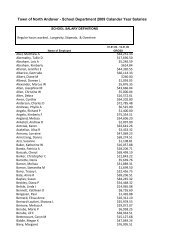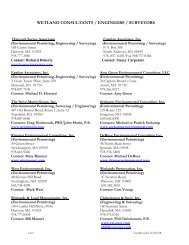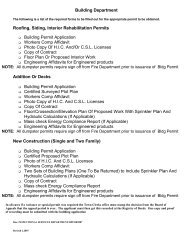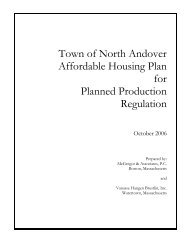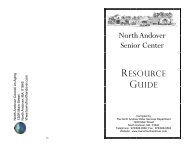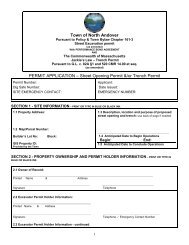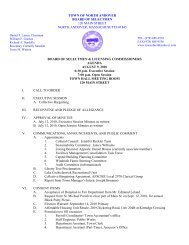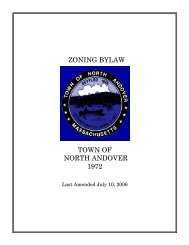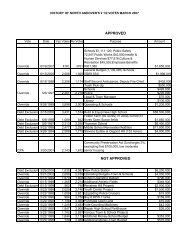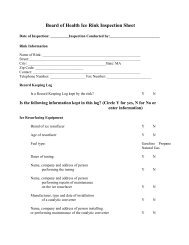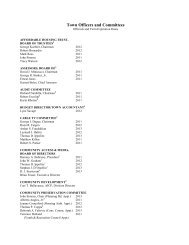Open Space and Recreation Plan - Town of North Andover
Open Space and Recreation Plan - Town of North Andover
Open Space and Recreation Plan - Town of North Andover
Create successful ePaper yourself
Turn your PDF publications into a flip-book with our unique Google optimized e-Paper software.
T O W N O F N O R T H A N D O V E R<br />
O P E N S P A C E A N D R E C R E A T I O N P L A N 2 0 0 6<br />
Farml<strong>and</strong><br />
2 0 1 0 U P D A T E<br />
Farml<strong>and</strong> has defined the <strong>Town</strong>'s character since the first settlers arrived. As previously discussed, most <strong>of</strong><br />
<strong>North</strong> <strong>Andover</strong>'s farml<strong>and</strong> has been replaced by residential development since the 1950s. As a response to this,<br />
the 1972 Comprehensive <strong>Plan</strong>'s first long- range goal was to "Retain the natural character <strong>of</strong> woodl<strong>and</strong>s, fields,<br />
<strong>and</strong> farms throughout the <strong>Town</strong> so that they can be used for recreation, conservation <strong>and</strong> enjoyment <strong>of</strong> open<br />
space to the extent possible" (Brown, 1972).<br />
Some l<strong>and</strong>owners file their property under certain taxation classifications such as Chapter 61, Forestry; Chapter<br />
61A, Agricultural <strong>and</strong> Horticultural L<strong>and</strong>s; <strong>and</strong> Chapter 61B, <strong>Open</strong> <strong>Space</strong> / Nature Area / <strong>Recreation</strong>.<br />
Presently fifteen (15) l<strong>and</strong>owners protect 1094.81 acres through the Chapter 61A. This is a 13% decrease since<br />
the 2000 <strong>Open</strong> <strong>Space</strong> & <strong>Recreation</strong> <strong>Plan</strong>. Additionally, there are four (4) l<strong>and</strong>owners that have filed under<br />
Chapter 61 <strong>and</strong> protect approximately 59.62 acres <strong>of</strong> forested areas, <strong>and</strong> three (3) l<strong>and</strong>owners are classified<br />
under Chapter 61B, preserving 62.17 acres open space. When the l<strong>and</strong>owner decides to sell the chapter l<strong>and</strong> or<br />
convert to a different use, the <strong>Town</strong> can exercise its first right <strong>of</strong> refusal to purchase the l<strong>and</strong>. The former<br />
Mazurenko Farm was purchased using this option in 1988 for the purpose <strong>of</strong> watershed protection <strong>and</strong> the<br />
preservation <strong>of</strong> farml<strong>and</strong>. Acquiring this parcel kept the crop <strong>and</strong> hay fields active, <strong>and</strong> eliminated the<br />
development <strong>of</strong> a residential subdivision with potentially harmful impacts on the community's water supply.<br />
This acquisition also triggered the Conservation Commission to create a farming program (agricultural use<br />
license) that allows local farmers to rent usable hay or crop fields. Not only does this program keep the old<br />
agricultural fields active, but it also provides the farmer with additional income <strong>and</strong> crop. To date, the<br />
Conservation Commission rents two (2) fields at Mazurenko Farm, Foster Farm, <strong>and</strong> Half Mile Hill. The most<br />
recent first right <strong>of</strong> refusal purchases was the Foster Farm (Chapter 61A) <strong>and</strong> the Cullen property (Chapter 61).<br />
Overall, little has been done proactively to preserve the remaining open fields <strong>and</strong> farml<strong>and</strong> that has helped to<br />
define the community character; although the <strong>Plan</strong>ned Residential Development (PRDs) concept has been used<br />
successfully to preserve hundreds <strong>of</strong> acres <strong>of</strong> open fields, wetl<strong>and</strong>s, <strong>and</strong> forested upl<strong>and</strong> areas.<br />
One reason why many people accept the loss <strong>of</strong> more natural l<strong>and</strong>scapes is the common misconception that<br />
there is a financial gain to the community from the conversion <strong>of</strong> these l<strong>and</strong> uses to residential or commercial<br />
development. A better underst<strong>and</strong>ing <strong>of</strong> the positive financial impact <strong>of</strong> l<strong>and</strong> preservation would hopefully<br />
improve the attitude <strong>of</strong> not only l<strong>and</strong>owners, but also municipal policy-makers toward l<strong>and</strong> preservation.<br />
Various studies, such as the American Farml<strong>and</strong> Trust (AFT) study previously cited, have shown that residential<br />
growth is more <strong>of</strong> a strain on local services than preserving open l<strong>and</strong>, forests <strong>and</strong> farml<strong>and</strong>. Over the last five<br />
(5) years, Massachusetts’ prime farml<strong>and</strong> has seen a 66% lost as a result <strong>of</strong> development.<br />
One common claim made to Massachusetts’ towns is that residential development increases the local tax base,<br />
thereby lowering property taxes. Others are that resource conservation is too expensive at the local level, <strong>and</strong><br />
that farml<strong>and</strong> does not make a significant contribution to the tax base, so it is best converted to its "highest <strong>and</strong><br />
best use," which is generally assumed to be development. The AFT found although residential development<br />
increases the local tax base, it does not pay for itself. These towns paid more on residential services than they<br />
received from residential services. (American Farml<strong>and</strong> Trust, 1992)<br />
24




